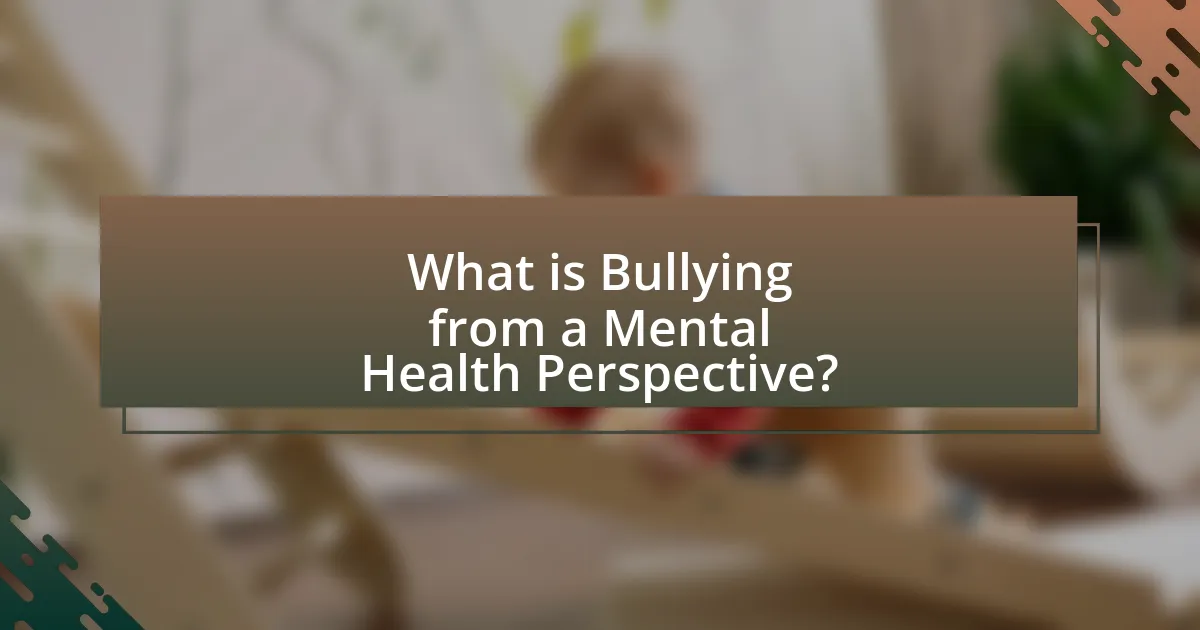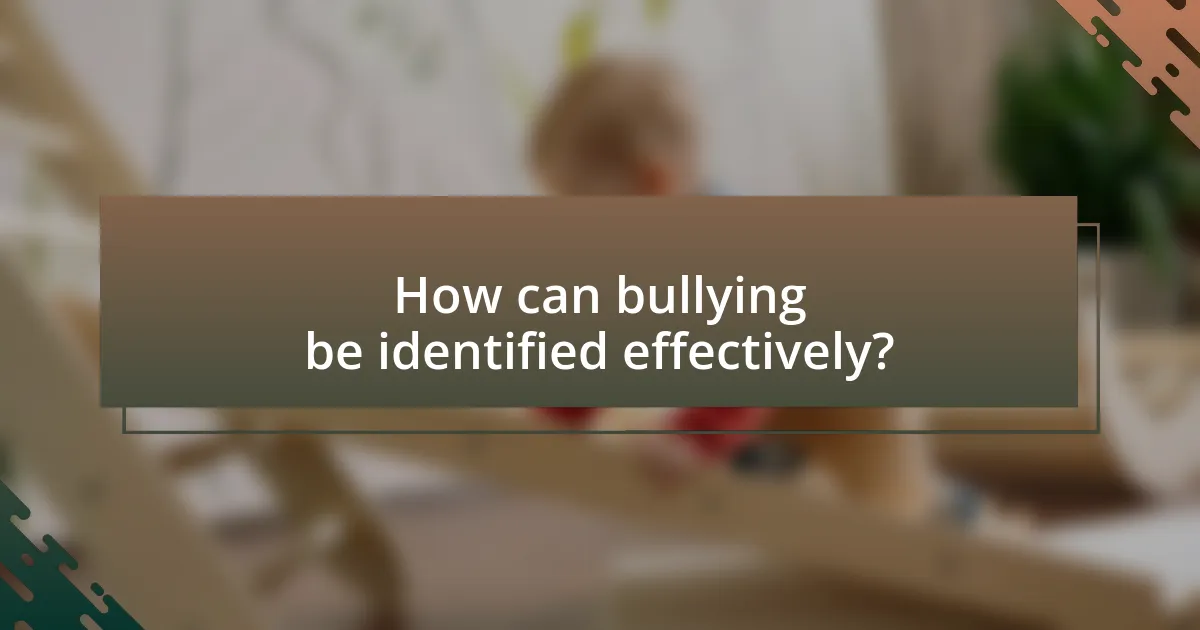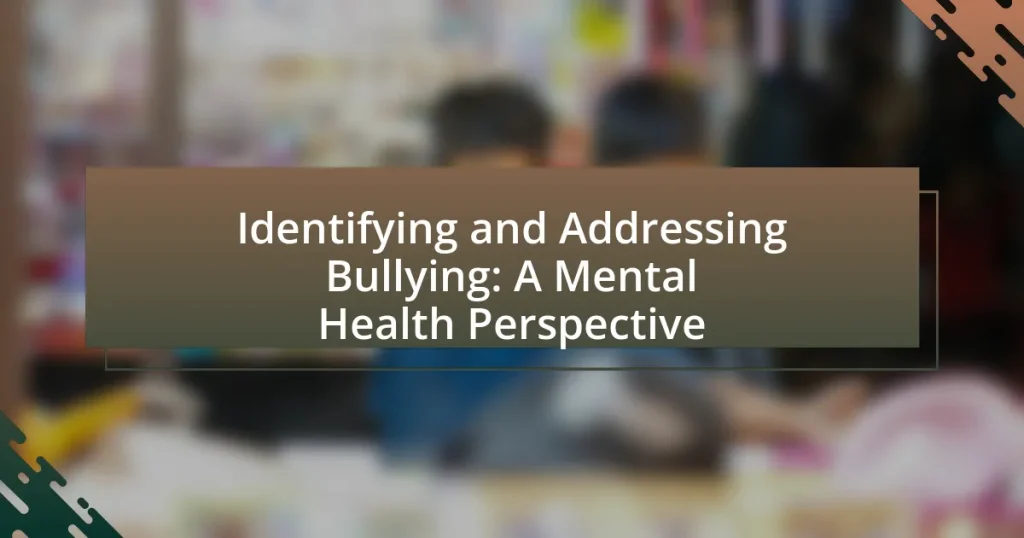Bullying, defined as repeated aggressive behavior involving an imbalance of power, poses significant mental health risks for both victims and perpetrators. This article explores the psychological effects of bullying, including increased anxiety, depression, and low self-esteem among victims, as well as potential mental health challenges faced by bullies. It examines various forms of bullying—physical, verbal, social, and cyberbullying—and their manifestations in different environments such as schools and workplaces. Additionally, the article highlights the importance of identifying bullying behaviors, the role of peers and adults in intervention, and effective strategies for addressing bullying to promote mental well-being.

What is Bullying from a Mental Health Perspective?
Bullying from a mental health perspective is a form of aggressive behavior that can lead to significant psychological harm for both the victim and the perpetrator. Research indicates that victims of bullying often experience anxiety, depression, and low self-esteem, which can persist into adulthood. For instance, a study published in the journal “Psychological Medicine” found that individuals who were bullied in childhood had a higher likelihood of developing mental health issues later in life, with a 1.5 to 2 times increased risk of anxiety and depression compared to those who were not bullied. Additionally, bullies themselves may also face mental health challenges, including increased aggression and antisocial behavior, as highlighted in research from the “Journal of Adolescent Health.” This dual impact underscores the importance of addressing bullying not only as a behavioral issue but also as a significant mental health concern.
How is bullying defined in psychological terms?
Bullying is defined in psychological terms as a repeated aggressive behavior that involves an imbalance of power, where one individual intentionally causes harm or distress to another. This definition is supported by the work of Olweus (1993), who identified key characteristics of bullying, including its intentional nature, the repetition of harmful acts, and the power disparity between the bully and the victim. Research indicates that bullying can lead to significant psychological effects on victims, including anxiety, depression, and low self-esteem, further validating the importance of understanding bullying within a psychological framework.
What are the different forms of bullying?
The different forms of bullying include physical, verbal, social, and cyberbullying. Physical bullying involves harming someone through physical actions, such as hitting or pushing. Verbal bullying includes using words to harm others, such as name-calling or threats. Social bullying, also known as relational bullying, involves damaging someone’s reputation or relationships, often through exclusion or spreading rumors. Cyberbullying occurs through digital platforms, where individuals harass or intimidate others online. According to the National Center for Educational Statistics, about 20% of students in the U.S. reported being bullied, highlighting the prevalence of these forms of bullying in educational settings.
How does bullying manifest in various environments?
Bullying manifests in various environments through distinct behaviors and dynamics. In schools, it often appears as physical aggression, verbal harassment, or social exclusion among peers, with studies indicating that approximately 20% of students experience bullying annually. In workplaces, bullying can take the form of intimidation, undermining, or spreading false information, affecting around 30% of employees at some point in their careers. Online environments, or cyberbullying, involve harassment through digital platforms, impacting nearly 15% of adolescents. Each environment has unique characteristics, but the underlying patterns of power imbalance and intentional harm remain consistent across settings.
Why is understanding bullying important for mental health?
Understanding bullying is crucial for mental health because it directly impacts emotional well-being and psychological development. Research indicates that individuals who experience bullying are at a higher risk for mental health issues such as anxiety, depression, and low self-esteem. For instance, a study published in the journal “Psychological Medicine” found that victims of bullying are more likely to develop mental health disorders later in life, with a significant correlation between bullying experiences and increased rates of depression and anxiety. Recognizing the signs and effects of bullying allows for timely intervention, which can mitigate these negative mental health outcomes and promote healthier coping strategies.
What are the psychological effects of bullying on victims?
The psychological effects of bullying on victims include increased anxiety, depression, and low self-esteem. Victims often experience feelings of isolation and helplessness, which can lead to long-term mental health issues. Research indicates that approximately 20% of bullied individuals develop anxiety disorders, while 15% may experience depression, according to a study published in the Journal of Adolescent Health. Additionally, victims may exhibit symptoms such as post-traumatic stress disorder (PTSD), with studies showing that bullying can lead to emotional distress that persists into adulthood. These effects highlight the significant impact bullying has on mental health, necessitating effective interventions.
How does bullying impact the mental health of bystanders?
Bullying negatively impacts the mental health of bystanders by causing feelings of anxiety, guilt, and helplessness. Research indicates that bystanders often experience emotional distress when witnessing bullying, which can lead to increased levels of depression and anxiety. A study published in the Journal of School Psychology found that bystanders who observe bullying are more likely to report psychological distress, with 20% of them experiencing significant emotional problems. This distress arises from the conflict between wanting to intervene and the fear of becoming a target themselves, leading to a sense of powerlessness.

How can bullying be identified effectively?
Bullying can be identified effectively through consistent patterns of aggressive behavior, intentional harm, and an imbalance of power. Observations of repeated negative interactions, such as verbal abuse, physical intimidation, or social exclusion, indicate bullying. Research shows that approximately 20% of students experience bullying, highlighting the prevalence and need for effective identification methods. Additionally, signs such as changes in a victim’s behavior, emotional distress, or reluctance to engage in social activities can further confirm the presence of bullying.
What signs indicate that someone may be a victim of bullying?
Signs that indicate someone may be a victim of bullying include sudden changes in behavior, such as increased anxiety, withdrawal from social interactions, and a decline in academic performance. Victims often exhibit physical signs like unexplained injuries, frequent complaints of headaches or stomachaches, and a noticeable change in eating or sleeping patterns. Additionally, they may express feelings of helplessness or low self-esteem, and they might avoid certain places or people. Research shows that approximately 20% of students experience bullying, highlighting the prevalence and impact of this issue on mental health.
What behavioral changes should be observed?
Behavioral changes that should be observed in individuals experiencing bullying include increased withdrawal from social interactions, noticeable changes in academic performance, and heightened emotional distress. These changes manifest as reluctance to engage in previously enjoyed activities, declining grades, and signs of anxiety or depression. Research indicates that victims of bullying often exhibit these behaviors due to the psychological impact of their experiences, which can lead to long-term mental health issues if not addressed. For instance, a study published in the Journal of Adolescent Health found that bullied adolescents are significantly more likely to report symptoms of depression and anxiety compared to their peers.
How can physical signs be recognized?
Physical signs can be recognized through observable indicators such as changes in body language, unexplained injuries, or alterations in appearance. For instance, a person exhibiting signs of bullying may display withdrawn posture, flinching at sudden movements, or having frequent bruises or scratches. Research indicates that these physical manifestations often correlate with emotional distress, as documented in studies on the psychological effects of bullying, which highlight the connection between physical symptoms and mental health issues.
What role do peers and adults play in identifying bullying?
Peers and adults play a crucial role in identifying bullying by observing behaviors and reporting incidents. Peers often witness bullying firsthand and can provide immediate support to victims, while adults, such as teachers and parents, are responsible for creating a safe environment and addressing reported incidents. Research indicates that when peers intervene or report bullying, it can significantly reduce the occurrence of such behavior, as highlighted in the study “The Role of Peers in Bullying: A Review of the Literature” by Salmivalli et al. (2013), which emphasizes the importance of peer involvement in recognizing and combating bullying. Additionally, adults are trained to recognize signs of bullying and can implement policies and interventions to address it effectively, reinforcing the need for both peer and adult engagement in the identification process.
How can friends support someone who is being bullied?
Friends can support someone who is being bullied by actively listening to their experiences and validating their feelings. This emotional support helps the victim feel understood and less isolated. Additionally, friends can encourage the bullied individual to seek help from trusted adults or professionals, which is crucial for addressing the situation effectively. Research indicates that social support from peers significantly reduces the negative psychological effects of bullying, as highlighted in a study published in the Journal of School Psychology, which found that supportive friendships can mitigate anxiety and depression in victims. Furthermore, friends can stand up against the bullying by intervening when they witness it, which not only helps the victim but also discourages the bully.
What should educators look for in school settings?
Educators should look for signs of bullying and its impact on mental health in school settings. This includes observing student interactions for aggressive behavior, social isolation, and changes in academic performance, which can indicate underlying bullying issues. Research shows that approximately 20% of students experience bullying, leading to increased anxiety and depression (National Center for Educational Statistics, 2021). Additionally, educators should assess the school environment for supportive resources, such as counseling services and anti-bullying programs, which are essential for addressing these issues effectively.

What strategies can be employed to address bullying?
To address bullying effectively, schools and organizations can implement comprehensive anti-bullying programs that include education, intervention, and support systems. Research indicates that programs like the Olweus Bullying Prevention Program have significantly reduced bullying incidents by fostering a positive school climate and promoting awareness among students, teachers, and parents. Additionally, establishing clear reporting mechanisms and providing counseling services for both victims and perpetrators can facilitate early intervention and support mental health. Studies show that schools with strong anti-bullying policies and training for staff see a decrease in bullying behaviors and an increase in student well-being.
How can victims of bullying seek help?
Victims of bullying can seek help by reporting the incidents to trusted adults, such as parents, teachers, or school counselors. This action is crucial as it initiates a support system and can lead to interventions that address the bullying behavior. According to the National Center for Educational Statistics, about 20% of students aged 12-18 experienced bullying in the 2018 school year, highlighting the prevalence of this issue and the importance of seeking help. Additionally, victims can access mental health resources, such as counseling services, which provide emotional support and coping strategies.
What resources are available for mental health support?
Mental health support resources include hotlines, therapy services, support groups, and online platforms. For instance, the National Suicide Prevention Lifeline offers 24/7 crisis support through a toll-free number, while organizations like the American Psychological Association provide directories for licensed therapists. Additionally, community mental health centers often offer low-cost or sliding scale services. Research indicates that access to these resources can significantly improve mental health outcomes, particularly for individuals affected by bullying, as highlighted in studies published by the Journal of School Psychology.
How can victims communicate their experiences effectively?
Victims can communicate their experiences effectively by using clear and specific language to describe their feelings and the events they encountered. This approach allows them to articulate the impact of bullying on their mental health, which is crucial for seeking support and intervention. Research indicates that victims who express their experiences in detail are more likely to receive appropriate help, as detailed accounts provide context that can lead to better understanding and action from listeners, such as peers, educators, or mental health professionals.
What interventions can schools implement to combat bullying?
Schools can implement several interventions to combat bullying, including anti-bullying policies, social-emotional learning programs, and peer mediation initiatives. Anti-bullying policies establish clear rules and consequences for bullying behavior, which can deter potential offenders. Research shows that schools with comprehensive anti-bullying policies report a 25% reduction in bullying incidents (Holt et al., 2015). Social-emotional learning programs teach students skills such as empathy, conflict resolution, and emotional regulation, leading to improved peer relationships and a decrease in bullying behavior. Additionally, peer mediation initiatives empower students to resolve conflicts amicably, fostering a supportive school environment. These interventions collectively contribute to a safer and more inclusive school climate.
How can anti-bullying programs be structured for effectiveness?
Anti-bullying programs can be structured for effectiveness by incorporating a comprehensive approach that includes education, intervention, and support systems. Effective programs should educate students, teachers, and parents about the dynamics of bullying, emphasizing empathy and conflict resolution skills. Research indicates that programs utilizing a whole-school approach, such as the Olweus Bullying Prevention Program, have shown significant reductions in bullying incidents, with a 20-50% decrease reported in various studies. Additionally, implementing clear policies and procedures for reporting and addressing bullying, along with providing support for both victims and perpetrators, enhances the program’s impact. Regular evaluation and adaptation of the program based on feedback and outcomes further ensure its effectiveness in reducing bullying behaviors.
What role does parental involvement play in addressing bullying?
Parental involvement plays a crucial role in addressing bullying by fostering open communication and providing emotional support to children. When parents actively engage in discussions about bullying, they help children recognize and articulate their experiences, which can lead to effective coping strategies. Research indicates that children with involved parents are more likely to report bullying incidents and seek help, as demonstrated in a study published in the Journal of School Psychology, which found that parental support significantly reduces the likelihood of victimization. Additionally, parents who collaborate with schools to implement anti-bullying policies create a safer environment, reinforcing the message that bullying is unacceptable.
What are some best practices for fostering a supportive environment?
To foster a supportive environment, it is essential to promote open communication, establish clear anti-bullying policies, and provide training for staff and students on empathy and conflict resolution. Open communication encourages individuals to express their feelings and concerns, which can help identify issues early. Clear anti-bullying policies create a framework for addressing bullying behavior, ensuring that everyone understands the consequences and support available. Training on empathy and conflict resolution equips individuals with the skills to navigate interpersonal challenges effectively, reducing the likelihood of bullying incidents. Research indicates that schools implementing comprehensive anti-bullying programs see a significant decrease in bullying behavior and an increase in student well-being, as highlighted in the study “The Effectiveness of School-Based Anti-Bullying Programs: A Meta-Analysis” by Ttofi and Farrington.
How can communities work together to prevent bullying?
Communities can work together to prevent bullying by implementing comprehensive programs that promote awareness, education, and support systems. Collaborative efforts among schools, parents, local organizations, and law enforcement can create a unified approach to address bullying. For instance, research from the National Center for Educational Statistics indicates that schools with anti-bullying policies and programs see a significant reduction in reported bullying incidents. Additionally, community workshops that educate parents and children about the effects of bullying and the importance of empathy can foster a supportive environment. By establishing clear reporting mechanisms and providing resources for victims, communities can effectively reduce the prevalence of bullying and promote mental well-being.
What strategies can be used to promote mental well-being among youth?
To promote mental well-being among youth, implementing strategies such as fostering supportive relationships, encouraging physical activity, and providing access to mental health resources is essential. Supportive relationships, including those with family, friends, and mentors, create a sense of belonging and security, which is crucial for emotional health. Research indicates that youth who engage in regular physical activity experience lower levels of anxiety and depression, highlighting the importance of incorporating exercise into daily routines. Additionally, access to mental health resources, such as counseling and educational programs, equips youth with coping skills and knowledge to manage stress and emotional challenges effectively. These strategies collectively contribute to a healthier mental state among young individuals.
What practical steps can individuals take to support those affected by bullying?
Individuals can support those affected by bullying by actively listening to their experiences and validating their feelings. This approach fosters a safe environment where victims feel heard and understood, which is crucial for their emotional well-being. Research indicates that supportive relationships can significantly mitigate the negative mental health effects of bullying, such as anxiety and depression. Additionally, individuals can encourage victims to seek professional help, such as counseling, which has been shown to provide effective coping strategies and emotional support. Furthermore, advocating for anti-bullying policies in schools and workplaces can create a safer environment for all, as studies demonstrate that structured interventions reduce bullying incidents and improve overall mental health outcomes.
